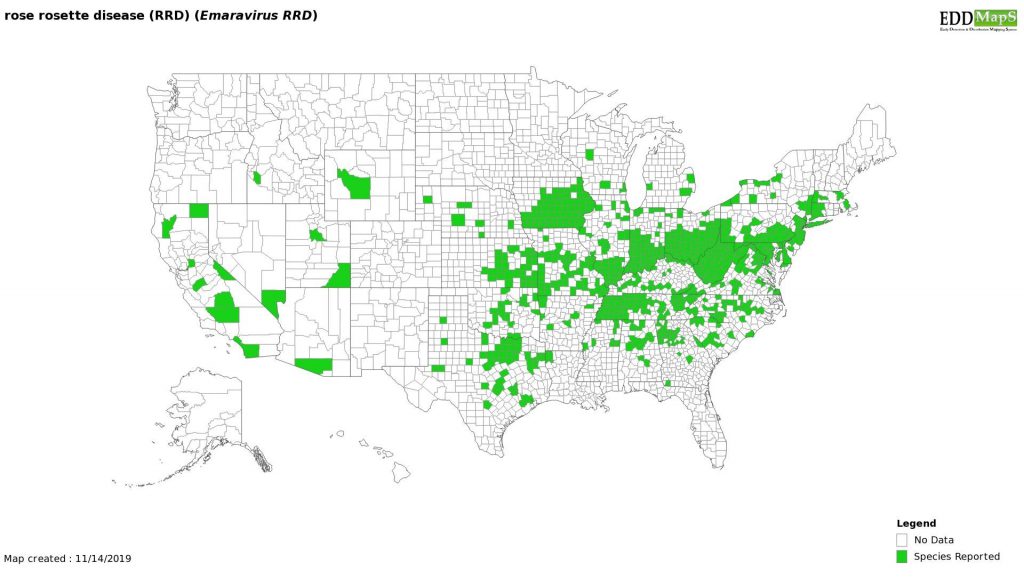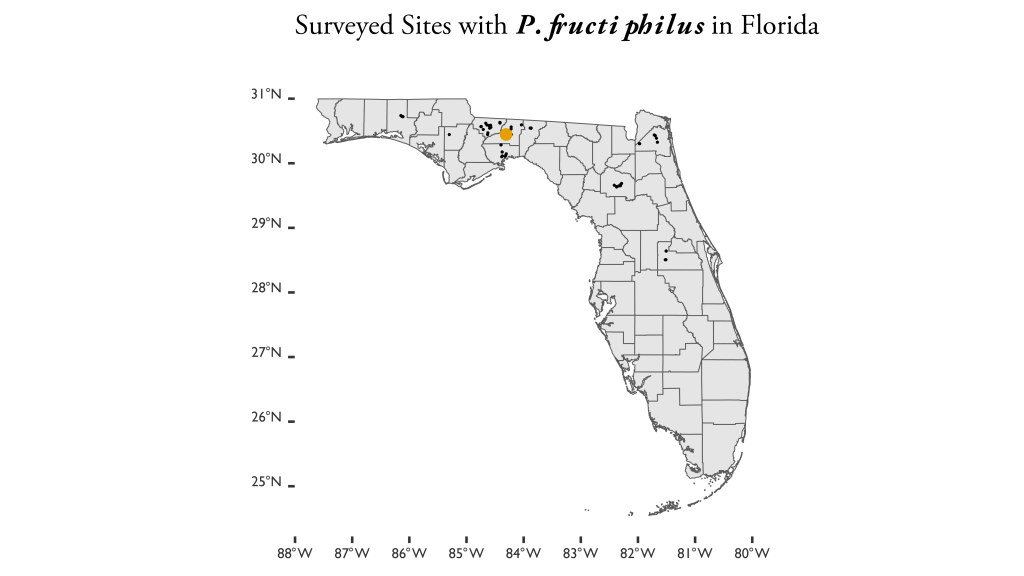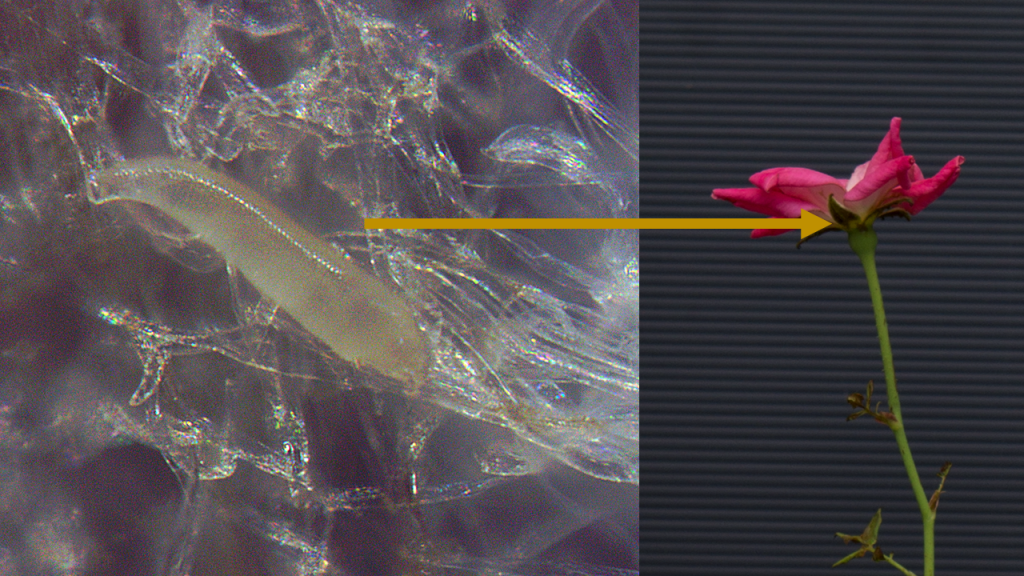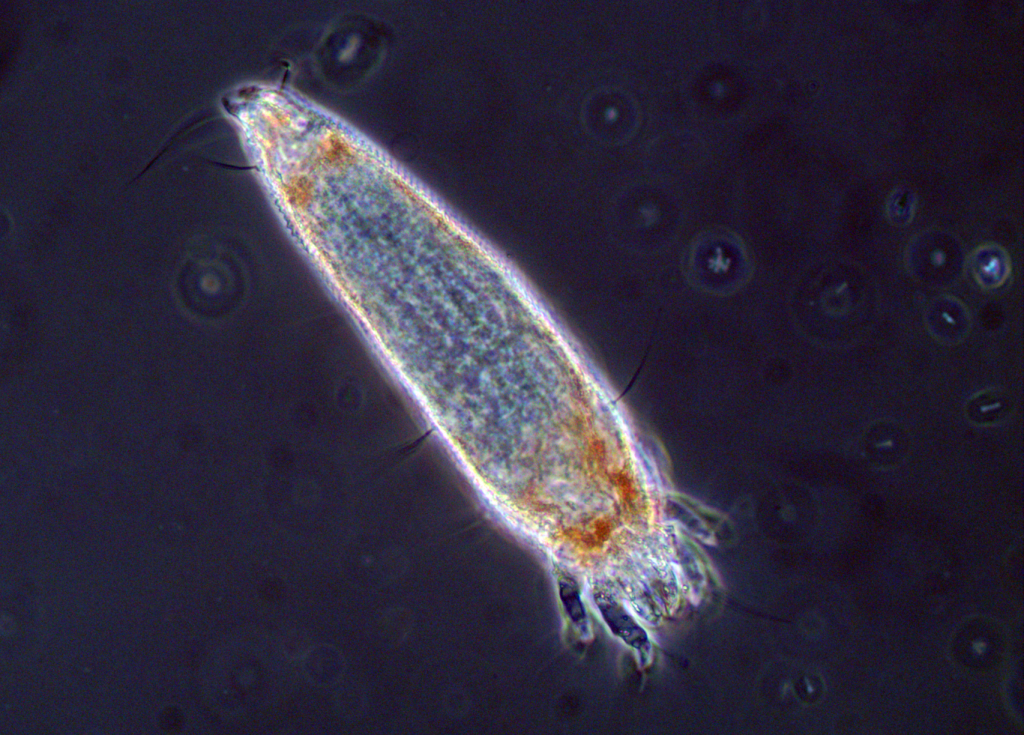Austin N. Fife, PhD student, Entomology
North Florida Research and Extension Center
Phyllocoptes fructiphilus: a new threat for Florida roses
Phyllocoptes fructiphilus Kefier is a microscopic plant-feeding arachnid belonging to a group of spindle-shaped mites known as Eriophyoid mites. Eriophyoid mites are second only to spider mites in their economic importance and potential for plant damage: some species create galls, others deform plants with their feeding activity, and a few species are capable of spreading viruses. Fortunately, eriophyoid mites very host specific and P. fructiphilus only feeds on plants in the genus Rosa, which includes all of the true roses which we are familiar with.
P. fructiphilus does not cause damage by its feeding alone, but is a pest due to its relationship as the vector of an emaravirus: Rose rosette virus (RRV). RRV infection creates Rose Rosette Disease (RRD), with the following symptoms: witches’ brooms/rosetting, deformed flowers, increased prickle density, elongated shoots, reddened leaves and stems, and increased die-back which ultimately kills the rose host. RRD is the most serious disease of roses, creating millions of dollars of losses for growers. Rose Rosette Disease and the mite have invaded the southeastern United States as the non-native Rosa multiflora (Thunb) has spread invasively towards the eastern coast and by the introduction of infected roses from out of state into Florida.

Figure 2: EDDMapS. 2020. Early Detection & Distribution Mapping System. The University of Georgia – Center for Invasive Species and Ecosystem Health. Available online at http://www.eddmaps.org/
RRD was initially detected in Florida in 2014 on 15 plants; however, the plants were destroyed and P. fructiphilus were not detected on the roses after that time.
In early 2019, a survey of predatory mites on roses found eriphyoid mites in samples obtained while surveying roses in Leon County, Florida. The mites were sent to the Florida Department of Agriculture and Consumer Services – Department of Plant Industry (FDACS-DPI) and were all identified as P. fructiphilus by Dr. Sam Bolton. To date, none of these roses have shown signs or symptoms of RDD and none of these plants have tested positive for presence of the virus.

Figure 3: Black dots indicate individual sites which have been surveyed for Phyllocoptes fructiphilus. Orange dots indicate a number of sites with populations of P. fructiphilus detected in Leon county, Florida. No symptoms of Rose Rosette Disease have been seen on these plants to date. Image Credit Austin N. Fife, UF / IFAS
This is the first recorded instance of P. fructiphilus in Florida and is worrisome despite the absence of the virus. Fortunately, RRV is currently not established in Florida. However, the presence of P. fructiphilus, along with past detections of RRV in Florida warrants an increase in monitoring efforts for the mite and virus in Florida.
How can I identify roses that have Rose Rosette Disease?
It is difficult to identify the symptoms of RRD in the field for a few reasons. Primarily, there are different growth habits for different rose cultivars. What appears to be ‘excessive thorniness’ in one cultivar may be normal for another, and is can be easy to mistake the redness of new flush with symptoms of the RRD. In addition, glyphosate damage from improper use of Roundup or similar products can have a very similar appearance to diseased roses. The best way to verify RRD infection is to use molecular testing for the virus. Identifying the presences of eriophyoid mites is useful for diagnosis, but they are too small to see with pocket loupes and are difficult to find unless there are large numbers of mites. To properly identify an eriophyoid mite as P. fructiphilus requires the use of a compound microscope with a specially prepared microscope slide of the mite, as well as reference materials and a trained individual who knows what characters to look for.
What to do if I suspect that my roses are infected with Rose Rosette Disease?
We recommend reporting suspected cases of RRD to your local extension agency or the Florida Department of Agriculture.
Where should I send my samples?
Plant Disease Diagnostic Clinic at the North Florida Research and Education Center in Quincy: https://nfrec.ifas.ufl.edu/plant-pathology-clinic/
Mathews Paret, Director, Plant Disease Diagnostic Clinic – UF NFREC (850) 875-7154, paret@ufl.edu
UF/IFAS Disease Diagnostic Center in Gainesville:
- 392-1795, pdc@ifas.ufl.edu
2570 Hull Rd Gainesville, FL 32603
Florida Department of Agriculture and Consumer Services – Division of Plant Industry
1-888-397-1517 Helpline (352) 395-4600 (Helpline Number, Outside of the United States) DPIHelpline@FDACS.gov
The Doyle Conner Building 1911 SW 34th St. Gainesville, FL 32608

Figure 5: Phyllocoptes fructiphilus is a refuge-seeking mite ,which hides under rose sepals, which are covered in tiny glandular plant hairs known as trichomes that protect the mites. Image Credit: Austin N. Fife, UF / IFAS
How Can I Manage Rose Rosette Disease?
Currently, there are no commercially available rose cultivars known to resist Rose Rosette Disease or Phyllocoptes fructiphilus. A major difficulty lies in the cryptic nature of these mites, which hide underneath the rose sepals. It is important to consider this when considering which control methods to use. Methods which require direct contact with the mites to kill them are unlikely to work.
This makes it difficult for chemical applications which require contact with the pest to work.
Keeping that in mind, there are a few things you can do to reduce your risk of RRD and prevent the spread of the mite:
- Eliminate infected wild roses nearby
- Heavy pruning followed by horticultural oil spray may reduce populations of the mite, but cannot prevent a viral infection from spreading.
- Space plants so their leaves and roots don’t touch
- Dispose of diseased roses properly: bag up infected materials and dispose of in areas away from other roses
- After removing infected plants, spray remaining plants with miticides recommended at https://roserosette.org/control/
- Spray uninfected plants adjacent to removed (infected) plants
- Yucca–A Tough and Versatile Native Plant - November 26, 2025
- Blazing Star - November 6, 2025
- University of West Florida’s New Heritage Roots Garden - October 17, 2025


